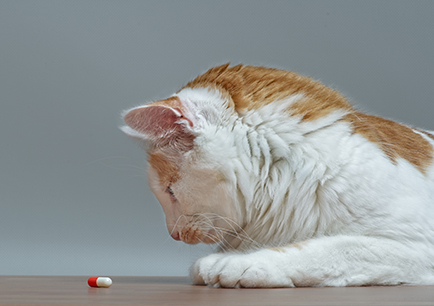How do fear, anxiety and stress impact your pet's health care?
A visit to the doctor or dentist makes many of us anxious, and the same holds true for our furry family members during a visit with the veterinarian. Even more so, because pets don’t understand the reason behind the treatments we perform, things like vaccines, blood collection and even simple handling can be very scary to them.
Unfortunately, one bad experience can influence a pet’s behaviour for life, and many animals become increasingly fearful as their medical needs increase over time. When this happens, it has a negative impact on the pet’s overall health as testing and treatment become more challenging and stressful for everyone involved, especially the pet!
Do we really need to use sedation?
While most pet owners are aware of their pet’s anxieties, they may not realize that there is more than can be done than just trying to comfort them with kind words and cuddles.
All veterinarians and technicians with Treatwell Pet Care and the Mobile Veterinary Services of Ottawa are Fear Free Certified Professionals. We pride ourselves on our kind and gentle approach which incorporates low-stress handling techniques, food rewards, natural anti-anxiety supplements and most of all, patience and a little extra time.
Still, this may not be enough, especially in cases where a pet has a pre-existing fear or phobia. In those cases, pre-appointment sedation can make a world of difference - better living through chemistry, as they say!
What is pre-appointment sedation?
Pre-appointment sedation, pre-visit pharmaceuticals, fear-free sedation and other similar terms all refer to the same things - oral sedatives an owner can administer to a pet at home about 1-2 hours prior to a stressful event. These drugs result in sedation that doesn’t knock a pet out completely, but rather makes them a little sleepy and less reactive to stimuli.
The most common drugs in use today include Gabapentin and Trazodone, although there are other alternatives as well. The drugs have a wide margin of safety in relatively-healthy patients. The most common side effects of these medications (aside from sedation, of course!) include pets being a little wobbly or looking “drunk”, and more rarely stomach upset or agitation.
Tips and tricks for giving medication to your pet
Giving oral medications to some pets is very easy, but in others (especially cats) it can often be a challenge. To help on this front, consider the following:
- The Double Wrap - Wrapping pills in a treat or pill-pocket is a given, but if Fido still manges to sniff out the medication consider this trick - go for the double wrap! For example, cover the pill in peanut butter, and then wrap that in a piece of white bread or even a marshmallow. This little dandy has fooled a number of canine detectives!
- The Rapid Fire - Start with 3-4 regular treats you know your pet loves. Given them in rapid succession, and follow that up immediately with the medication wrapped in something tasty. Often the momentum of all of these treats will help carry you through.
- Mix It Up - Mix the medication into canned food or another soft treat like peanut butter or cream cheese. Butter is another good one that works well for cats. Capsules can often be opened, and their contents sprinkled into food to help disguise their taste.
- A Little Hunger Doesn't Hurt - Consider skipping your pet’s previous meal to make sure they are extra hungry come time for their tasty medication-containing morsel - this will help increase your chance of success.
- Compounding Solutions - Ask your veterinarian about different medication formats. Many of these medications can be compounded into liquids or even chewable treats that many pets will gobble up!
Everybody is different
The sedation that results from these medications will vary tremendously from patient-to-patient, and will even vary in a single patient depending on the circumstance. For that reason, you may have to work with your veterinarian to come up with the best drugs, doses and overall plan for your pet.
As part of establishing this plan, it’s often helpful to try a “test dose” at home first, prior to trying it for a medical visit. You should do this on a day when you are home to observe your pet.
- This will help you gauge how effective the medication is for your pet, and how long it takes to get to maximum effect as this can vary as well.
- It will help establish whether or not your pet has any side effects from the drug in question - if they occur it will wear off within a few hours and your veterinarian will help come up with alternatives


